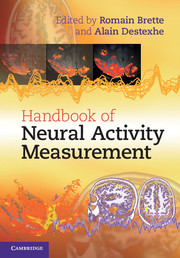Book contents
- Frontmatter
- Contents
- List of contributors
- 1 Introduction
- 2 Electrodes
- 3 Intracellular recording
- 4 Extracellular spikes and CSD
- 5 Local field potentials
- 6 EEG and MEG: forward modeling
- 7 MEG and EEG: source estimation
- 8 Intrinsic signal optical imaging
- 9 Voltage-sensitive dye imaging
- 10 Calcium imaging
- 11 Functional magnetic resonance imaging
- 12 Perspectives
- Plate section
- References
9 - Voltage-sensitive dye imaging
Published online by Cambridge University Press: 05 October 2012
- Frontmatter
- Contents
- List of contributors
- 1 Introduction
- 2 Electrodes
- 3 Intracellular recording
- 4 Extracellular spikes and CSD
- 5 Local field potentials
- 6 EEG and MEG: forward modeling
- 7 MEG and EEG: source estimation
- 8 Intrinsic signal optical imaging
- 9 Voltage-sensitive dye imaging
- 10 Calcium imaging
- 11 Functional magnetic resonance imaging
- 12 Perspectives
- Plate section
- References
Summary
Introduction
Modern neuroimaging and computational neuroscience are two recent neuroscience disciplines that are very important for understanding brain mechanisms. Optical imaging gives the opportunity of observing the brain in activity at the level of large populations of neurons with high resolution. Many types of optical imaging techniques exist, but only two are usually used in vivo (see Grinvald et al., 1999, for a detailed review): the first is based on intrinsic optical signals and records brain activity indirectly, the second is based on voltage-sensitive dyes (VSDs) and reports postsynaptic neuronal activation in real time. In this review, we focus on the second technique, aiming at a better understanding of the origin of the optical signal. Extensive reviews of VSDI have been published elsewhere (Roland, 2002; Grinvald and Hildesheim, 2004).
This amazing technique is based on complex interaction with the system which is not yet fully understood. Indeed, the recorded signal (VSD signal) originates from a large amount of intermingled neuronal and glial membrane components and it seems difficult to isolate the contributions from the different components. Combined intracellular recording with VSDI has demonstrated a linear correspondence between the VSD signal and membrane potential of an individual neuron, but so far no studies have focused on what exactly the VSD signal actually measures when applied to a cortical population in vivo.
Experimental approaches are not really feasible because the available methodologies do not offer the possibility to inspect simultaneously all the components that may contribute to the signal.
- Type
- Chapter
- Information
- Handbook of Neural Activity Measurement , pp. 327 - 361Publisher: Cambridge University PressPrint publication year: 2012

